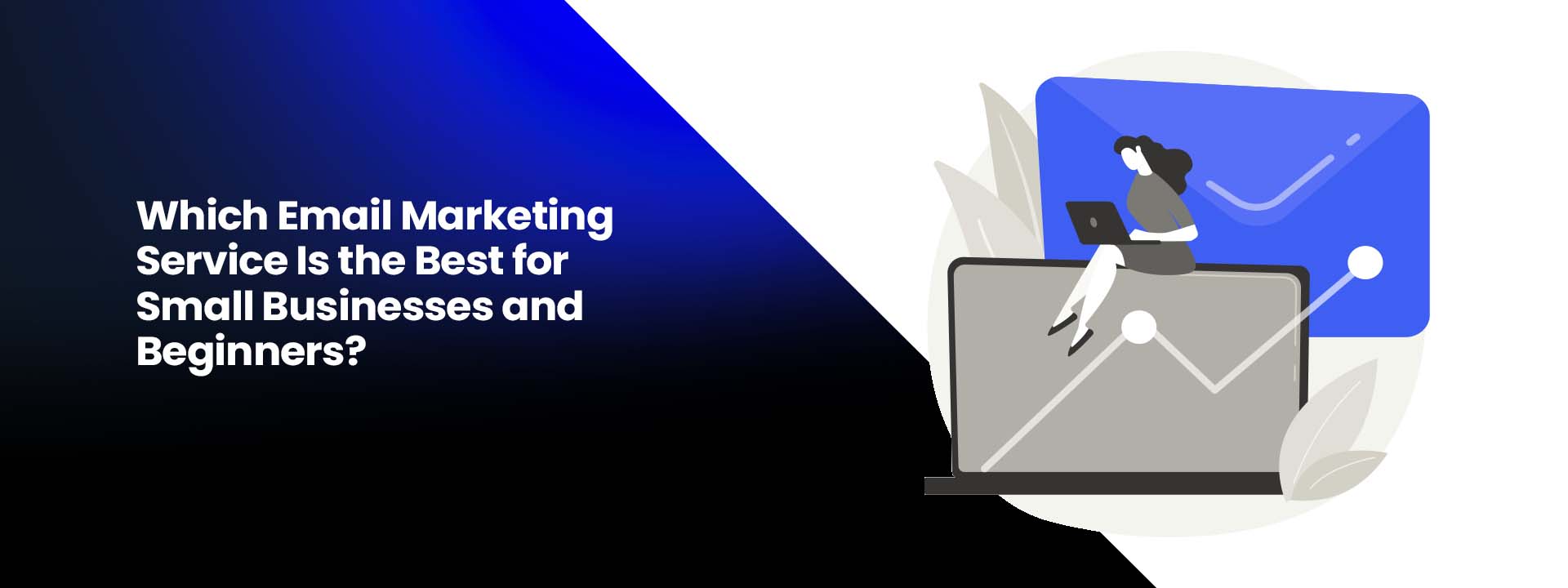Which Email Marketing Service Is the Best for Small Businesses and Beginners?
Published on: 24 October, 2025

Why Choosing the Right Platform Matters
If you’re curious about which email marketing services, you’re not alone. Small businesses and first-time marketers often sift through many providers, trying to balance usability, price, and performance. The right platform will help you launch quickly, boost conversions, and scale without complicated setups. In this guide, we will compare what makes the best email marketing service unique, how to assess bulk email marketing services, and where the true value lies for small teams.
- You’ll learn which features truly benefit small businesses and beginners.
- You’ll also understand the costs of email marketing services and how to stay compliant while sending at scale.
How to Evaluate Email Platforms (Before You Commit)
Before you get too excited about a flashy dashboard, define your desired outcomes. Do you need to send simple newsletters every week? Are you creating multi-step funnels that involve automation, segmentation, and conditional logic? The platform you choose should meet your current goals and grow with your list. Beginners often benefit from a straightforward drag-and-drop builder, sensible defaults, and built-in guidance.
Next, evaluate the onboarding experience and learning curve. A great tool should guide you from importing contacts to sending your first campaign in minutes, not days. Look for tooltips, sample campaigns, and a digital marketing company in pakistan email template library that includes newsletters, promotions, product launches, and re-engagement flows. Templates save hours and prevent blank-page paralysis—especially if you’re handling content, graphic design agency, and strategy by yourself.
The Features That Matter Most for Small Businesses
Small businesses usually don’t need every feature that larger enterprises do. What they need is a reliable editor, easy list management, and clear reporting. The best tools make common tasks simple, like growing your list with embedded forms, tagging contacts based on behavior, and sending a branded campaign without using code. If it takes more than a few clicks to create a decent email, you’ll send fewer campaigns.
Deliverability is equally important. Look for providers that assist with setting up authentication (SPF, DKIM, DMARC) with step-by-step instructions. A solid sending infrastructure, smart throttling for bulk email marketing services, and list hygiene tools (like managing bounces and complaints) protect your sender reputation. When your emails reach the inbox, your overall marketing performance better.
Best Overall Pick for Small Businesses (Ease + Growth)
For most small businesses, the “best overall” platform offers three key benefits: intuitive editing, built-in automation, and fair pricing that doesn’t increase unexpectedly as you grow. Focus on providers with a generous free or low-tier plan so you can test real campaigns before committing. Many small teams start with weekly newsletters and then move on to abandoned cart reminders, win-back flows, and post-purchase follow-ups using the same tool.
Equally important is how well the platform fits your ecosystem. If you run an online store, choose a platform with integrated e-commerce features, dynamic product blocks, and revenue tracking. If you’re in a service-based business, ensure the provider works well with your booking system, CRM, or landing page builder. The best choice is the one that suits your needs, not the one with the longest list of features.
Best Pick for Beginners (Fast Setup + Handholding)
Beginners thrive on clarity. Choose a platform that feels like a guided tour: import a CSV, select the best seo services in pakistan email template, customize branding, and press send—without tutorials on a second screen. An easy builder with reusable content blocks, inline image editing, and real-time previews can turn a first-time sender into a confident marketer in one afternoon.
Also, look for “starter automation recipes,” such as welcome series, lead magnet delivery, newsletter opt-ins, and simple if/then rules. These templates allow you to create useful automations without learning flowcharts. Over time, you can add complexity—like branching for engaged vs. unengaged subscribers—without changing platforms.
Understanding the Cost of Email Marketing Services (Without Surprises)
Pricing can often be confusing due to subscriber-based tiers, email send limits, and extra fees for features like advanced automation or SMS. When exploring the cost of email marketing services, align pricing with your current list size and realistic growth over the next year. Calculate the effective cost per 1,000 sends and check whether overages are billed automatically or will pause sending to protect your budget.
Don’t forget the “time cost.” If you spend extra hours per campaign struggling with the editor, the “cheaper” platform may not actually save you money. Consider the value of built-in deliverability tools, automation templates, and integrations that don’t require custom coding. The best option is the one that lowers your total costs while maintaining high outcomes.
Templates, Branding, and Content Velocity
A strong template library is a game-changer for growth. Look for modern, mobile-friendly designs that you can brand quickly—logos, fonts, colors, buttons, and social media links. Seek sections designed for product features, testimonials, FAQs, and promotions. The quicker you can build a campaign, the more often you will send, leading to increased revenue.
If you offer social media marketing agency services to clients, ensure your provider supports multi-brand management or folders so you can store a top 10 digital marketing companies in pakistan email template set by client or campaign type. Versioning, saved content blocks, and brand kits reduce inconsistency and speed up approvals—especially helpful if you’re juggling several business lines.
Bulk Email Marketing Services: Deliverability and Scale
As your list expands, bulk email marketing services require more than just pressing “send.” You need list hygiene tools, suppression lists, and automatic management of bounces and complaints. Ask if your provider offers warming sequences for new domains and precise sending controls to prevent flooding ISPs and triggering filters.
Monitoring is essential. Track inbox placement, not just open rates. Use seed lists, authentication checks, and spam-word scanners. The best platforms proactively identify risky content, image-to-text ratios, and link issues. They make good sending practices the default, ensuring your campaigns reach real people instead of spam folders.
Automation, Segmentation, and Personalization That Actually Convert
Even beginners can benefit from simple automation. Start with a welcome series that introduces your brand, shares helpful content, and offers a clear next step. Add features like abandoned checkout or lead magnet delivery to create a mini funnel. Over time, segmentation (based on tags, events, or past purchases) will help you send fewer, more relevant emails that convert better.
Personalization goes beyond “Hi, <First Name>.” Use dynamic content blocks to change offers based on interests, location, or stage in the customer journey. Incorporate data from your CRM or store to make emails feel timely and specific. The more relevant your message, the better your email marketing will perform in terms of revenue and retention.
Compliance, Consent, and List Health
Regardless of which provider you choose, compliance is essential. Use double opt-in when necessary, keep consent records, and provide a clear unsubscribe option. Set clear expectations during sign-up: what you’ll send, how often, and what subscribers will gain. Transparency enhances engagement and minimizes complaints, both vital for maintaining long-term deliverability.
Regularly remove inactive subscribers. Many platforms can help you identify cold contacts and run re-engagement campaigns. If a subscriber doesn’t respond, remove them. A smaller, active list often performs better than a large, inactive one, protecting your sender reputation in the process.
Migration: Moving Without Losing Momentum
If you’re changing providers, export your contacts with tags, segments, and consent fields intact. Recreate your core automations first, like welcome series, lead delivery, and abandoned flows. Then import your most effective templates so you can start sending right away while rebuilding the rest.
Plan for a brief overlap where both platforms are active. Authenticate your new sending domain, gradually increase the volume of sends, and monitor performance. Once your new provider shows consistent inboxing and stable engagement, make the full switch.
Decision Framework: Picking the Best Fit Today
Here’s a quick framework you can apply right now:
- List size & growth: Choose a plan that fits your current numbers and realistic growth over the next year.
- Use cases: Just newsletters, or newsletters plus automations and e-commerce triggers?
- Time to value: Can you import, brand, and send a campaign within an hour?
- Total cost: Subscription, time, additional features, and overage risks.
- Deliverability: Support with authentication, list hygiene, and proactive assistance.
Take a provider’s trial for a spin with a real campaign. Import a small segment, pick a website design and development services email template, personalize it, and send. If you can’t accomplish this quickly, the tool isn’t beginner-friendly—no matter how powerful it looks.
Recommended Starter Stack (Actionable Next Steps)
Start with a platform known for a clean user experience, solid automation features, and transparent pricing. Build your first three assets: a branded newsletter template, a welcome series (two to three emails), and a basic promo template for launches and offers. Add an embedded form to your website and create a lead magnet that addresses a real problem for your audience.
From there, schedule a consistent sending frequency, such as weekly or bi-weekly, and track opens, clicks, and conversion events aligned with your goals. As you grow, add segmentation (for engaged vs. unengaged), product-based personalization, and event triggers. Keep your list clean, your content valuable, and your calls to action straightforward.
Final Thought
For small businesses and beginners, the best email marketing service is the one that lets you send your next campaign today and grows with you tomorrow. Prioritize ease of use, built-in support, honest pricing, and features that ensure good deliverability. With those criteria met, you will grow faster and spend less time struggling with tools, allowing you to focus on building relationships that drive revenue.
FAQ’s
1. What things matter most when picking a solid email marketing tool?
Choosing an email marketing tool means looking at how well messages arrive in inboxes, whether it’s simple to operate, handling contact lists smoothly, setting up auto-sent campaigns, splitting audiences plus tracking results, linking with your sales or customer system, costs that change depending on how many subscribers you’ve got, also checking if help is easy to get when needed.
2. How does subscriber list size and pricing impact which service is best for my business?
Lots of email tools charge more as your audience grows or you send more messages. When your contact list expands, pick one with low-cost plans, easy changes, clear costs – no lengthy deals or sudden spikes once you grow.
3. Do tiny firms or new ventures manage fine with basic email tools – or do they actually need top-tier options every time?
Small companies might begin with simpler tools – particularly when mailing lists aren’t huge. Even so, core functions like auto-responses, grouping contacts, or pre-made layouts should stay covered. Once expansion kicks in and needs to shift toward real-time tracking, personalized messages, or syncing with other apps, stepping up to a stronger plan makes sense.
4. How does auto-sending stuff plus splitting up lists affect picking a top email tool?
A solid platform’s gotta track what users do – then shoot off welcome notes, reminders for abandoned carts, or check-in messages when folks go quiet. It splits your list by likes, location, age, whatever fits. Tweak what each group sees so it feels less generic.
5. Why does email delivery matter, yet shape your decision?
Getting emails into people’s inboxes instead of junk folders matters a lot. If most messages get blocked, the whole effort falls apart. While picking an email tool, look at its track record, how it handles warming up new IPs, whether it supports key security setups like SPF or DKIM, ways it deals with failed sends, along with clear reports on delivery success.




